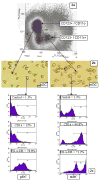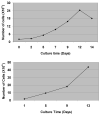A plasmacytoid dendritic cell (CD123+/CD11c-) based assay system to predict contact allergenicity of chemicals
- PMID: 19665512
- PMCID: PMC2747095
- DOI: 10.1016/j.tox.2009.07.021
A plasmacytoid dendritic cell (CD123+/CD11c-) based assay system to predict contact allergenicity of chemicals
Abstract
A predictive allergenicity test system for assessing the contact allergenicity of chemicals is needed by the cosmetic and pharmaceutical industry to monitor product safety in the marketplace. Development of such non-animal alternative assay systems for skin sensitization and hazard identification has been pursued by policy makers and regulatory agencies. We investigated whether phenotypic and functional changes to a subset of dendritic cells (DC), plasmacytoid DC (pDC), could be used to identify contact allergens. To achieve this goal, normal human DC were generated from CD34+ progenitor cells and cryopreserved. Frozen DC were thawed and the pDC fraction (CD123+/CD11c-) was harvested using FACS sorting. The pDC were cultured, expanded, and exposed to chemical allergens (N=26) or non-allergens (N=22). Concentrations of each chemical that resulted in >50% viability was determined using FACS analysis of propidium iodide stained cells using pDC from 2 to 5 donors. Expression of the surface marker, CD86, which has been implicated in dendritic cell maturation, was used as a marker of allergenicity. CD86 expression increased (> or =1.5-fold) for 25 of 26 allergens (sensitivity=96%) but did not increase for 19 of 22 non-allergens (specificity=86%). In a direct comparison to historical data for the regulatory approved, mouse local lymph node assay (LLNA) for 23 allergens and 22 non-allergens, the pDC method had sensitivity and specificity of 96% and 86%, respectively, while the sensitivity and specificity of the LLNA assay was 83% and 82%, respectively. In conclusion, CD86 expression in pDC appears to be a sensitive and specific indicator to identify contact allergenicity. Such an assay method utilizing normal human cells will be useful for high throughput screening of chemicals for allergenicity.
2009 Elsevier Ireland Ltd.
Figures




Similar articles
-
A novel method to generate monocyte-derived dendritic cells during coculture with HaCaT facilitates detection of weak contact allergens in cosmetics.Arch Toxicol. 2017 Jan;91(1):339-350. doi: 10.1007/s00204-016-1722-y. Epub 2016 Apr 30. Arch Toxicol. 2017. PMID: 27136899
-
In vitro detection of contact allergens: development of an optimized protocol using human peripheral blood monocyte-derived dendritic cells.Toxicol In Vitro. 2011 Feb;25(1):315-23. doi: 10.1016/j.tiv.2010.09.016. Epub 2010 Oct 29. Toxicol In Vitro. 2011. PMID: 20932890
-
Mechanistic understanding of dendritic cell activation in skin sensitization: additional evidences to support potency classification.Toxicol Lett. 2020 Apr 1;322:50-57. doi: 10.1016/j.toxlet.2020.01.014. Epub 2020 Jan 17. Toxicol Lett. 2020. PMID: 31958493
-
Interactions of contact allergens with dendritic cells: opportunities and challenges for the development of novel approaches to hazard assessment.Toxicol Sci. 2005 Nov;88(1):4-11. doi: 10.1093/toxsci/kfi245. Epub 2005 Jul 13. Toxicol Sci. 2005. PMID: 16014741 Review.
-
The local lymph node assay and potential application to the identification of drug allergens.Toxicology. 2001 Feb 2;158(1-2):59-64. doi: 10.1016/s0300-483x(00)00408-x. Toxicology. 2001. PMID: 11164993 Review.
Cited by
-
Alternative Methods for Skin-Sensitization Assessment.Toxics. 2022 Nov 29;10(12):740. doi: 10.3390/toxics10120740. Toxics. 2022. PMID: 36548573 Free PMC article. Review.
-
Modulation of immunity and inflammatory gene expression in the gut, in inflammatory diseases of the gut and in the liver by probiotics.World J Gastroenterol. 2014 Nov 14;20(42):15632-49. doi: 10.3748/wjg.v20.i42.15632. World J Gastroenterol. 2014. PMID: 25400447 Free PMC article.
-
Modulation of Dendritic-Epithelial Cell Responses against Sphingomonas Paucimobilis by Dietary Fibers.Sci Rep. 2016 Jul 25;6:30277. doi: 10.1038/srep30277. Sci Rep. 2016. PMID: 27452116 Free PMC article.
-
Cell-free culture supernatant of Bifidobacterium breve CNCM I-4035 decreases pro-inflammatory cytokines in human dendritic cells challenged with Salmonella typhi through TLR activation.PLoS One. 2013;8(3):e59370. doi: 10.1371/journal.pone.0059370. Epub 2013 Mar 12. PLoS One. 2013. PMID: 23555025 Free PMC article.
-
Lactobacillus paracasei CNCM I-4034 and its culture supernatant modulate Salmonella-induced inflammation in a novel transwell co-culture of human intestinal-like dendritic and Caco-2 cells.BMC Microbiol. 2015 Apr 1;15(1):79. doi: 10.1186/s12866-015-0408-6. BMC Microbiol. 2015. PMID: 25887178 Free PMC article.
References
-
- Ashikaga T, Hoya M, Itagaki H, Katsumura Y, Aiba S. Evaluation of CD86 expression and MHC Class II molecule Internalization in THP-1 human monocyte derived cells as predictive endpoints for contact sensitization. Toxicology in Vitro. 2002;16:711–716. - PubMed
-
- Ayehunie S, Garcia-Zepeda EA, Hoxie JA, Horuk R, Kupper TS, Luster AD, Ruprecht RM. Human immunodeficiency virus-1 entry into purified blood dendritic cells through CC and CXC chemokine coreceptors. Blood. 1997;90:1379–86. - PubMed
-
- Basketter DA, Lea LJ, Cooper K, Stocks J, Dickens A, Dearman RJ, Kimber I. Threshold for classification as a skin sensitizer in the local lymph node assay: A statistical evaluation. Food and Chemical Toxicology. 1999;37:1167–1174. - PubMed
-
- Basketter DA, Smith Pease CK, Patlewicz GY. Contact allergy: the local lymph node assay for the prediction of hazard and risk. Clin Exp Dermatol. 2003;28:218–221. - PubMed
-
- Grindon C, Combes R, Balls M. Toxicity testing: Creating a revolution based on new technologies. Trends in Biotechnology. 2005;23:299–307. - PubMed
Publication types
MeSH terms
Substances
Grants and funding
LinkOut - more resources
Full Text Sources
Medical
Research Materials

